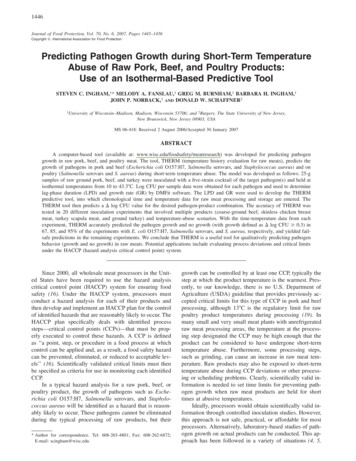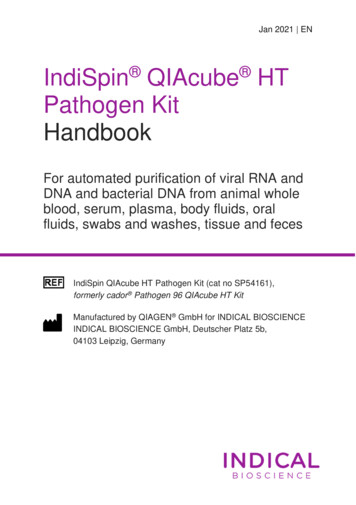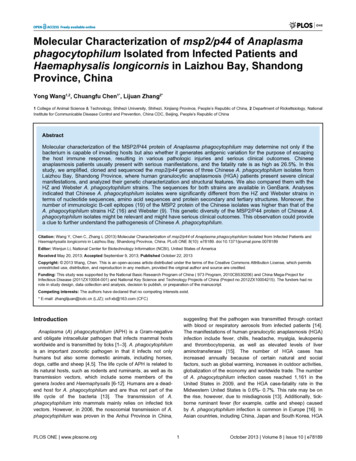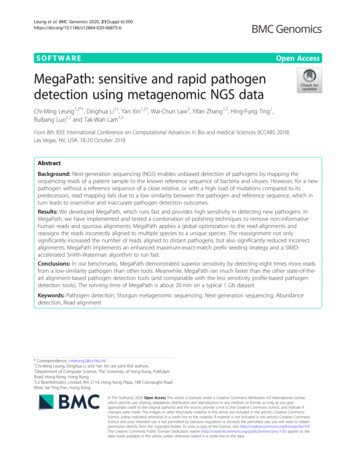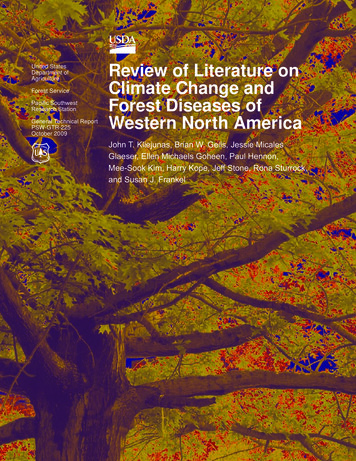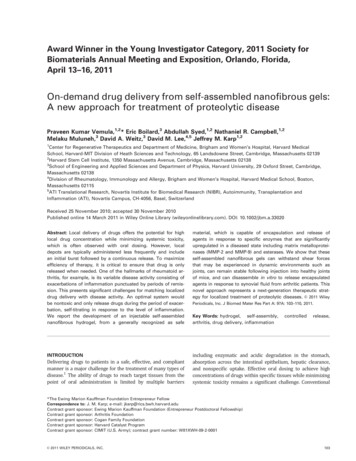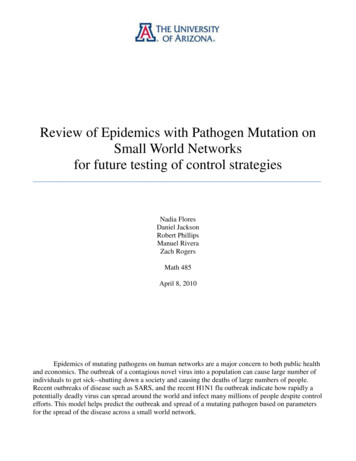
Transcription
Review of Epidemics with Pathogen Mutation onSmall World Networksfor future testing of control strategiesNadia FloresDaniel JacksonRobert PhillipsManuel RiveraZach RogersMath 485April 8, 2010Epidemics of mutating pathogens on human networks are a major concern to both public healthand economics. The outbreak of a contagious novel virus into a population can cause large number ofindividuals to get sick--shutting down a society and causing the deaths of large numbers of people.Recent outbreaks of disease such as SARS, and the recent H1N1 flu outbreak indicate how rapidly apotentially deadly virus can spread around the world and infect many millions of people despite controlefforts. This model helps predict the outbreak and spread of a mutating pathogen based on parametersfor the spread of the disease across a small world network.
IntroductionEpidemiology is the study of infections over a network of people. And epidemic is the widespread infection of a group of individuals in contact with each other and people not yet infected. It isimportant to study both the history and potential future of epidemics as diseases such as AIDS andPandemic Flu, which have killed millions worldwide, is critical to public health. In 2009, InfluenzaA(H1N1/09) emerged. Though not as catastrophic as initially feared, Influenza A(H1N1/09) wasgenetically close to the Spanish Flu strain of the early 20th Century that killed millions worldwide. Itdemonstrated how a highly contagious novel virus could rapidly spread to all nations on Earth in lessthan one year. Studying disease spread across socio-spatial networks is an important aspect inunderstanding disease-contraction dynamics and determining methods to limit outbreak [1].Creating accurate and effective models of pathogen-spread and containment is an importantasset in determining the danger of an infectious strain. Programs such as childhood-immunization [2],have benefited from effective models. Rapidly mutating diseases present some of the most dangerouscases for natural pandemic or bio-terrorist attack [1].Many models have been created to map the spread of a disease for these purposes. However,there are few models that incorporate both pathogen mutation and a realistic socio-spatial network [1].Societal realities, such as stronger links between family members than strangers, are important aspectsfor the spread of a pathogen. The interaction between immunity and pathogen mutation also affects thedynamics. Models based on uniform mixing of a network are not realistic. Individuals spend more timewith their families, coworkers, and friends than with strangers. Though not true representations ofsocial-spatial networks, small-world networks capture two key features of true social networks. Theyare highly clustered; two nodes which share a neighbor are likely to themselves be neighbors.Furthermore the diameter, the minimum number of vertices between any two nodes, of the graphincreases only logarithmically with network size [3].2
The paper Epidemics with pathogen mutation on small-world networks written by Zhi-GangShao, Zhi-Jie Tan, Xian-Wu Zhou, Zhun-Zhi Jin, all faculty in the physics department of WuhanUniversity, was the original source for this type of model. We replicated their model and results withthe intention of engaging in future studies into this area. The authors created their model as a morerealistic study of disease outbreak on society [1].Review of Author’s ModelSIRS ModelThe model being proposed is an S(susceptible)I(infected)R(immune)S(susceptible) model. Anynode in the network progresses from susceptible to infection, to infected, to immune, and back tosusceptible as time progresses. The model also includes pathogen mutation meaning that immunity toall the strains moving through the system at a time step is less likely. Simpler models are SIS, and SIRmodels. In SIS models there is no immunity stage and an individual can become infected immediatelyafter it has recovered. In SIR models once infected an individual retains immunity for the rest of time.And SIRS model is a better model for studying the pathogens with higher epidemic risk.Small World NetworksA small world network is a collection of N nodes, which act as individuals. The nodes eachhave a history which records the strains they have been infected with or are currently infected with. Thenodes are connected together creating the network. The model requires that we create multiple differentnetworks to run it on. To create the networks each node starts out in a linear sequence connected to its2k nearest neighbors, the first and last nodes being next to each other. To turn this from a fullysymmetric network to a small world network the model goes from node to node and rewires each of thek, clockwise connections to a random node, with a probability p, and maintains the connection withprobability 1-p. The model prevents both self-connections and multiple connections between twonodes. Small-world behavior occurs when the probability of rewiring a connection is larger than 1/N3
[3] The authors had network sizes vary from 104 to 106 and took p 0.01, well within the small worldrange [1].Example of small world network with increasing p the randomness of the network increases.D.J. Watts and S.H. Strogatz, Nature 393 (1998), p. 440.Mutating pathogenEach node can be in one of three states. S-susceptible to infection, I-infected, and R-immune.Once an individual in state S is infected it passes into the immune-state after the infection time τi. Theindividual stays immune until the end of the immunity duration τR. This is referred to a SIRS model.Including mutation into the model causes new strains to appear in the system, these new strains caninfect individuals immune to previous strains. However, immunity is conferred if the new strain issimilar enough to old strains in the immune response memory.Pathogens are represented using a bit-string model, in which each pathogen strain is representedby a unique bit-string of length l, i.e. 1010000011. These bit-strings serve as abstract representations ofthe genetic code of the pathogen [1]. Mutation is carried out by flipping a single digit in the bit stringrepresentation. Mutations can occur only during an infection event, and do so with probability µ 0.01. An individual will be immune to any pathogens similar to ones in its immunity repertoire [1].The similarity between strains is measured by the l1 norm, the hamming-distance. Since each bit-string4
is length l, the total number of possible strains is 2l and with 105 nodes it is likely that mutations willcause a large number of strains to be present at any one time.The epidemic is started by randomly choosing one node to be infected with the initial strain000.000. At each time-step, infected nodes send challenge-strains to their nearest neighbors,simulating contact with infectious individuals. The challenge-strain is then compared to the immunityrepertoire of the neighboring node. If the minimum hamming-distance between the challenge-strain andall the strains in the repertoire of the neighboring node is greater than hthr, the cross-immunitythreshold, then the neighboring node becomes infected.To simplify the model each strain has the same immunity duration, infection time, mutationprobability and cross-immunity threshold. The length of the bit string is set to l 10 and the infectiontime is set to τi 1 for all variations of the parameters studied [1].The numerical model was implemented in C . Since this is a stochastic model, data gatheredfor each variation of network parameters was run over ten different networks with at least fifty runs pernetwork. This was to account for the randomness inherent in the construction of the networks and inmutation events (parameters p and μ, respectively). The resulting data was then averaged to a singledata set. The original authors averaged data for ten networks with one hundred runs each. Timeconstraints and the limitations of our computing power prevented exact replication of the previouseffort.ResultsCase 1: Effect of immunity durationThe simulation was run for immunity duration, τR 50, 150, 450. The cross-immunity threshold hthr 2. The network size was set to N 105. The figure shows the fraction of infectious individuals as afunction of the time step.5
Replicated model resultsPhysica A 363 (2006) 561-566 by Zhi-Gang Shao, Zhi-Jie Tan,Xian-Wu Zhou, Zhun-Zhi JinFigure 1: Plots of fraction infected against time, for immunity duration τR, Cross-immunity threshold hthr 2, andpopulation N 105.Case 2: Effect of cross-immunity thresholdThe simulation was run for hthr 0,2,4, and 10. The immunity duration, τr 150, and the populationsize was again N 105. Figure 2 shows the fraction of infected individuals as a function ofdimensionless time.Replicated model resultsPhysica A 363 (2006) 561-566 by Zhi-Gang Shao, Zhi-Jie Tan,Xian-Wu Zhou, Zhun-Zhi JinFigure 2: Fraction of infected individuals as a function of time step t for cross immunity threshold h thr, immunityduration τR 150.6
Case 3: Effect of population sizeThe simulation was run for network sizes, N 104,105,106. The immunity duration τr 150, and theCross-Immunity Threshold hthr 2. The figures 3a and 3b show the number of infected nodes as afunction of time.Replicated model resultsPhysica A 363 (2006) 561-566 by Zhi-Gang Shao, Zhi-Jie Tan,Xian-Wu Zhou, Zhun-Zhi JinFigure 3: Number of infected individuals as a function of time step t for population N 10 5, immunity duration τr 150, and population N 105.DiscussionCase 1(Effect of immunity duration)(Figure 1) In both the original results and the replicated models up to the 100th time step thethree simulations have the same fraction of individuals infected. Furthermore, immunity durations of150 and 450 have the same time dependent dynamics up to the 200th time step.For large τR values, e.g. τR 450, the infection spreads quickly initially but then dies out. Moderatevalues of τR, e.g. τR 150, a decaying oscillation occurs. Small values of τR, e.g. τR 50 the infectionrapidly spreads then becomes persistent, this case will be hard to contain and control, and represents thegreatest threat for pandemic [1].7
Case 2(Effect of cross-immunity threshold)(Figure 2) In the original and replicated models the dependence on the cross-immunitythreshold is dramatic. For hthr 0 any challenge strain will infect the node the system rapidly tendstowards a constant infection rate of 100%. This is a reduction to the SIS model. For a hthr 10, the bitstring length the model reduces to an SIR model. Lower cross immunity between strains leads to morerapid outbreak and greater public health threat. This can be seen with seasonal influenza, the new strainarriving each flu season is outside the cross-immunity threshold of the previous year’s influenza virus,and therefore annual inoculation is required.Case 3(Effect of population size)(Figure 3) In both models the size of the network does not affect the initial dynamics of thesystem. The number of infected in all three cases grows towards a maximum before the effect of theimmunity duration comes into play. These simulations run with τR 150, display the dampedoscillations for moderate immunity duration lengths. The dynamics for population size only vary atlater time. The smaller networks reach equilibrium quicker than the large networks. Not repeated in thereplicated results but in the authors model for the smallest population size, the number of infectedreduces with time, ultimately resulting in the elimination of the pathogen from the system.SIRS Model on a small-world networkThe SIRS model with pathogen mutation on small-world networks presents special results notpresent in other models. As shown SIRS models with pathogen mutation have parameter sets whereoscillations can occur in the fraction of individuals infected. Mutation leads to an increase in thenumber of nodes infected, while immunity leads to a decrease in the fraction infected. The small worldnetwork affects the dynamics because the rewiring creates long-range connections [1]. A long rangeconnection allows infection to spread across the network to previously uninfected areas of the graph.These long range connections increase the spread of pathogen strains.8
DiscrepanciesIn repeating the work of the previous authors, we ran into a few discrepancies that future workshould attempt to explain. First, in all three cases the fraction of the number infected in our work washigher than the original work. When testing the cross-immunity threshold our averages were exactlyfour times larger than the authors. Secondly, for network size N 104, the authors reported that thenumber of infected decayed to zero for larger times. In our results the number infected displayed thesame damped oscillations as the larger networks.ConclusionMutating pathogens are a major threat to public health. The interaction of the immune responseand disease mutation leads to oscillations in the number of infected when the outbreak is on a smallworld network. In real socio-spatial networks this is also the case as novel pathogens can rapidlyspread across a network if a majority of individuals are immune. Understanding when a pathogen willnot naturally be eliminated from the network, as in the saturation and oscillation cases, forces societiesto take steps to reduce its impact and attempt to eradicate it. In the 20th century the eradication ofSmall Pox from circulation due to a massive immunization effort represents the lone success in trulyeliminating a harmful pathogen from the planet. Novel pathogens created by random chance mutationssuch as the case of the H1N1/2009 pandemic will always be a scourge on society. This model can beused to assess effectiveness of countermeasures to epidemics such as H1N1/2009. Being betterprepared to deal with the next pandemic could save millions of lives.Future WorkHaving successfully replicated the fundamental behavior of the previous work, we now focusour attention on expanding the model to more accurately reflect the susceptibility of various individualsto infectious agents. We will then ask certain questions of our model, comparing our results to realworld data.9
To that end, our objectives are two-fold. Firstly, we would like to enhance the model to reflectvariable susceptibility. Not all individuals are equally susceptible to infection. The elderly, infants,those being treated with immuno-suppressant drugs and persons with immune-deficiencies caused bydiseases such as HIV, are more likely to contract a virus if an outbreak occurs. We will be studying howpopulations with diverse demographics (age, health, etc.) handle an outbreak of a mutating pathogen.We also intend to compare our results to real world data, from the World Health Organization andothers.Our second objective is to examine how to best go about stopping an outbreak once it hasoccurred. Much time and money is expended in trying to quell outbreaks. Sometimes these effortsproduce large amounts of waste, as evidenced by the recent dumping of vast amounts of H1N1 vaccine.To combat this waste and stop an outbreak we would like to know who and how many people toinoculate, and when to inoculate them. In particular we will look at vaccinating a proportion of arandom sampling of the population, at vaccinating certain susceptible individuals such as the elderly,and at vaccinating those who come in contact with large segments of the public (represented by highlyconnected nodes in our small-world network model), such as taxi drivers, bus drivers, mail-persons,and teachers.10
References[1] Zhi-Gang Shao, Zhi-Jie Tan, Xian-Wu Zhou, Zhun-Zhi Jin, Physica A 363 (2006) 561-566.[2]B.T. Grenfell, O.N. Bjornstad, J. Kappey, Nature 414 (2001) 716.[3] R. Albert, A.-L. Baraba si, Rev. Mod. Phys. 74 (2002) 47.11
Math 485 April 8, 2010 Epidemics of mutating pathogens on human networks are a major concern to both public health and economics. The outbreak of a contagious novel virus into a population can cause large number of . Mutation is carried out by flipping a single digit in the bit string representation. Mutations can occur only during an .

